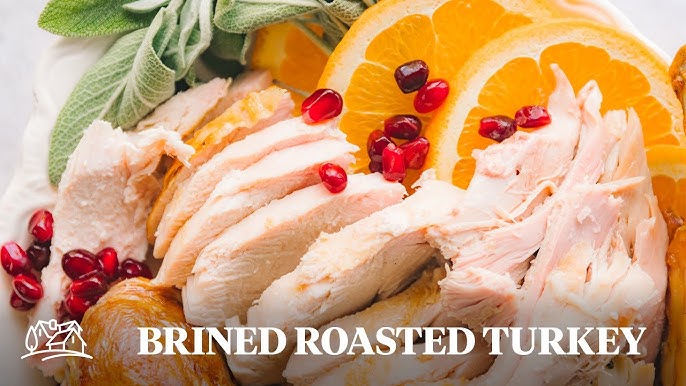Turkey Brine Recipe: Brining is a simple technique that involves soaking your turkey in a saltwater solution. It helps the meat absorb moisture and flavor, ensuring a tender, juicy bird. Brining is especially useful for lean meats like turkey, which tend to dry out during cooking. Whether you’re roasting or grilling, brining gives your turkey the best shot at staying moist.
Why Brine a Turkey?
Brining serves two main purposes: to keep the meat moist and to infuse it with flavor. The salt solution helps the turkey absorb water, preventing it from drying out, while the herbs, spices, and sweeteners add depth to every bite. Think of it as a marinade, but better!
Types of Brine: Wet vs. Dry
There are two ways to brine a turkey: wet brine and dry brine.
- Wet Brine: Submerging the turkey in a liquid mixture of water, salt, and aromatics.
- Dry Brine: Rubbing the bird with a salt mixture and letting it rest in the fridge.
Which one is better? Wet brine ensures a juicy turkey, but it takes up more space. Dry brine is easier but requires more time.
Ingredients for a Basic Turkey Brine
Here’s what you’ll need for a classic wet brine:
- Water: Acts as the base of the brine.
- Salt: Kosher salt works best; it helps lock in moisture.
- Aromatics: Garlic, thyme, rosemary, peppercorns, and bay leaves.
- Sweeteners: Brown sugar, honey, or maple syrup to add a subtle sweetness.
- Citrus: Orange or lemon slices for a bright, fresh flavor.
Essential Tools for Brining
- Brining Bag or Large Container: Ensure the turkey is fully submerged.
- Meat Thermometer: To monitor cooking after brining.
- Cooler or Refrigerator: Keep the turkey cold throughout the process.
How to Make a Wet Brine – Step-by-Step
- Measure Ingredients: Use 1 gallon of water and 1 cup of kosher salt for every 5 pounds of turkey.
- Simmer Ingredients: In a large pot, combine water, salt, aromatics, and sweeteners. Bring to a simmer for 5-10 minutes to dissolve the salt and infuse the flavors.
- Cool Completely: Allow the brine to cool before adding the turkey—hot brine will start cooking the meat.
How to Brine a Turkey (Wet Brine Method)
- Prepare the Turkey: Remove the giblets and pat the turkey dry.
- Submerge in Brine: Place the turkey in the brine, ensuring it’s fully covered. Use a brining bag or large container.
- Refrigerate for 12-24 Hours: Place the turkey in the fridge or cooler with ice packs to keep it cold.
How to Dry Brine a Turkey (Alternative Method)
- Apply Salt and Aromatics: Rub kosher salt, herbs, and spices all over the turkey, including under the skin.
- Refrigerate Uncovered: Place the turkey on a rack in a pan and let it rest uncovered in the fridge.
- Rest for 24-48 Hours: The longer the turkey rests, the more flavorful and tender it will be.
How Long Should You Brine a Turkey?
Brining times vary based on the size of the bird. As a rule of thumb:
- 10-12 lb Turkey: 12-18 hours
- 12-16 lb Turkey: 18-24 hours
- 16-20 lb Turkey: 24-36 hours
Avoid brining for longer than 48 hours, as it can make the meat mushy or overly salty.
Preparing the Turkey After Brining
- Rinse (Optional): Some prefer to rinse off excess salt, though it’s not always necessary.
- Pat Dry: Ensure the turkey is completely dry to get crispy skin when roasting.
Common Mistakes to Avoid
- Over-Brining: Don’t leave the turkey in the brine too long.
- Too Much Salt: Stick to the recipe to avoid an overly salty bird.
- Not Cooling the Brine: Adding a hot brine to the turkey can ruin it.
Cooking the Brined Turkey
Once brined, roast the turkey as you normally would. Set the oven to 325°F (163°C), and cook the turkey until the internal temperature reaches 165°F (74°C) in the thickest part of the breast.
What to Do with Leftover Turkey Brine?
- Dispose Properly: Since raw meat has soaked in the brine, it’s not safe to reuse.
- Make Gravy: Some people reserve a portion of unused brine to add to gravy for extra flavor.
FAQs about Turkey Brine Recipe
1. Why should I brine my turkey?
Brining a turkey helps to lock in moisture and enhance the flavor, making the meat juicier and more flavorful after cooking. This process is especially beneficial for lean meats like turkey that tend to dry out during cooking.
2. What are the basic ingredients for a turkey brine?
A basic turkey brine recipe includes water, salt, sugar, and a variety of spices and aromatics. Common additions include garlic, bay leaves, peppercorns, and herbs like rosemary and thyme.
3. How long should I brine my turkey?
For optimal results, brine your turkey for at least 12-24 hours. However, do not brine for more than 48 hours as it can cause the turkey to become too salty.
4. Can I make a no-salt turkey brine?
Yes, a no-salt brine typically involves using fruit juices, vinegar, and aromatics to infuse the turkey with flavors without the added salt. However, the texture of the meat may differ slightly from salt-based brines.
5. Do I need to refrigerate my turkey while it brines?
Yes, it is important to keep the turkey refrigerated during the brining process to prevent bacterial growth. Ensure that the brining container is fully submerged and kept at a safe temperature below 40°F (4°C).
6. How do I cook a brined turkey?
After brining, rinse the turkey under cold water and pat dry. Cook as you normally would, whether roasting, grilling, or deep-frying. Remember, a brined turkey may cook faster, so keep a thermometer handy to avoid overcooking.
7. Can I reuse turkey brine?
For safety reasons, turkey brine should not be reused. It contains raw juices which may harbor bacteria, so it’s best to discard the brine after use.
Conclusion
Brining is the secret to a juicy, flavorful turkey that will impress everyone at the table. Whether you opt for a wet or dry brine, following these steps will elevate your cooking game and ensure you get perfect results every time. Give it a try this holiday season—you won’t regret it!
References
For those interested in exploring more about turkey brining and its culinary benefits, here are some well-regarded resources that provide in-depth insights and further validate the techniques discussed in our Turkey Brine Recipe guide:
- The Kitchn – Offers a comprehensive guide on why brining is essential for your Thanksgiving turkey and how it enhances flavor and moisture. Available at The Kitchn’s Complete Guide to Turkey Brining.
- Serious Eats – Features a detailed article by culinary experts on the science behind turkey brining and its impact on protein structures, ensuring juicier results. Read more at Serious Eats: The Science of Brining.
- Epicurious – Provides a variety of turkey brine recipes and discusses the differences in outcomes depending on the ingredients used. Explore more at Epicurious Turkey Brine Recipes.
- Food Network – Hosts several recipes and video tutorials on turkey brining techniques from renowned chefs, which can help visual learners. Visit Food Network Turkey Brining Techniques.
These resources are highly recommended for their reliable content and expert advice, ensuring that your culinary endeavors yield the best results.



